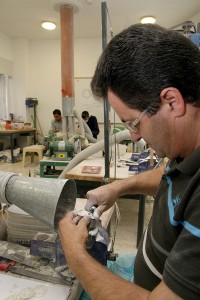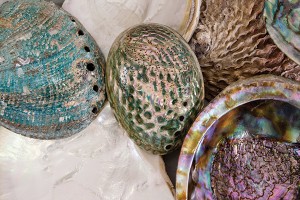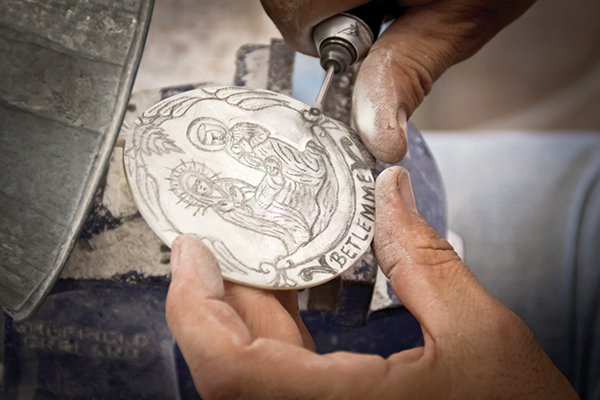 Archaeological excavations in the area of Bethlehem have proven that the town’s mother-of-pearl industry is a centuries-old tradition. In addition, the use of small mother-of-pearl tiles can be seen in the twelfth-century mosaics that decorate the walls of the Church of the Nativity. However, the true turning point in the development of mother-of-pearl art took place around the fourteenth century. This was when Franciscan friars who settled in Bethlehem introduced its carving to the local community as an income-generating handicraft.
Archaeological excavations in the area of Bethlehem have proven that the town’s mother-of-pearl industry is a centuries-old tradition. In addition, the use of small mother-of-pearl tiles can be seen in the twelfth-century mosaics that decorate the walls of the Church of the Nativity. However, the true turning point in the development of mother-of-pearl art took place around the fourteenth century. This was when Franciscan friars who settled in Bethlehem introduced its carving to the local community as an income-generating handicraft.
At the end of the sixteenth century, a new important shift occurred in the mother-of-pearl design. Bernardino Amico, one of the Franciscans who was living in Jerusalem, made technical drawings of the churches of the Holy Sepulcher and the Nativity and commissioned local artisans in Bethlehem to produce multiple copies based on his designs. To produce the miniatures of the monasteries, the craftsmen used a combination of olive wood and mother-of-pearl inlays. This initiated a long tradition of producing replica models of holy shrines in Palestine developed in Bethlehem, and increasingly mother-of-pearl was used as the main material. The evolution of the art continued until it reached its peak in the late-nineteenth and early-twentieth centuries.
Unfortunately, in the mid-twentieth century, the craft started to vanish, and currently there are very few artisans who still practice this art that they learned from their ancestors. Today, there are only 25 mother-of-pearl workshops in the Bethlehem and Beit Sahour area, compared to the more than 300 enterprises around 50 years ago.
Previously, most of the oysters for the mother-of-pearl supply came from the Red Sea. Nowadays, the shells are imported from various countries, especially Australia, India, Indonesia, Malaysia, and Mexico. The artisans face various restrictions in the importation of the raw material, leading to rising production costs.
 Yet it is still possible to find places in Bethlehem where the production of mother-of-pearl art is cultivated. Salesian Artistic Centre, established in 2005, aims to conserve this time-honored profession. A visit to the center is a must for anyone who would like to view talented artisans engaged in their precise work and learn about the process and tradition of making Palestinian handicrafts. The center also provides short- and long-term creative courses in mother-of-pearl, olive wood, and ceramics production. Salesian Artistic Centre can be visited every day, except Fridays and Sundays. Contact the center to arrange your visit.
Yet it is still possible to find places in Bethlehem where the production of mother-of-pearl art is cultivated. Salesian Artistic Centre, established in 2005, aims to conserve this time-honored profession. A visit to the center is a must for anyone who would like to view talented artisans engaged in their precise work and learn about the process and tradition of making Palestinian handicrafts. The center also provides short- and long-term creative courses in mother-of-pearl, olive wood, and ceramics production. Salesian Artistic Centre can be visited every day, except Fridays and Sundays. Contact the center to arrange your visit.
Salesian Artistic Centre
Catholic Stairs, 316 Star Street, Bethlehem
Office Tel./Fax: +972-2-276-0076
salartcenter@hotmail.com
Read an article by George Al Ama about the history of mother-of-pearl art, on which this text was based: http://www.fondazionegp2.org/?p=386.
» Article courtesy of: visitpalestine.ps.
» Article photos: courtesy of Salesian Artistic Centre.

